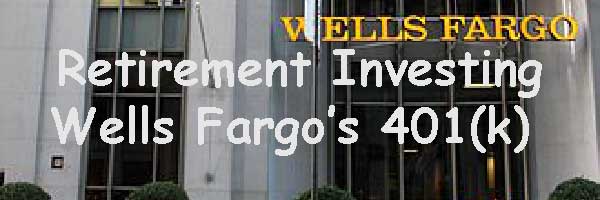How do Wells Fargo employees approach 401k retirement investing?
Wells Fargo offers a 401(k)-retirement savings plan for its 300,000+ plan participants. Accordingly, these Wells Fargo employees can choose to contribute a portion of their income to the plan.
But which investments do Wells Fargo employees pick as retirement investments? We will get to that, but first let’s go over why it is important.
What is a 401(k) Retirement Savings Plan?
A 401(k) plan is a powerful retirement savings tool provided by employers in the United States. It empowers employees to set aside a portion of their earnings before taxes are deducted, leading to immediate tax savings.
Here’s how it works:
Tax-Advantaged Savings: With a 401(k), you can invest a percentage of your income before income taxes are calculated. This reduces your taxable income, which can result in lower tax bills during your working years.
Investment Opportunities: The funds you contribute are invested in various options within the plan, such as mutual funds. This allows your money to potentially grow over time through market investments.
Employer Contributions: Many employers sweeten the deal by matching a percentage of your contributions, effectively adding free money to your retirement fund. It’s like getting a bonus for saving.
Tax-Deferred Growth: Your 401(k) investments grow tax-deferred until you decide to withdraw the funds in retirement. This means you won’t pay taxes on the gains or dividends your investments earn within the account.
Withdrawals in Retirement: When you retire and begin taking withdrawals from your 401(k), the funds are then subject to regular income tax. However, you may be in a lower tax bracket during retirement, potentially reducing your tax burden.
Roth 401(k) Option: Markedly, some plans offer a Roth 401(k) option. With this choice, you contribute after-tax dollars, but your withdrawals in retirement are tax-free. Undeniably, a valuable option if you anticipate being in a higher tax bracket in retirement.
A 401(k) retirement savings plan belongs to the category of defined contribution plans, where your retirement income depends on your contributions, investment choices, and market performance. It’s a crucial tool for building a secure financial future, providing both immediate tax advantages and long-term growth potential. So, as you plan for retirement, remember that your 401(k) is your ally in securing your financial well-being.
Wells Fargo 401(k) Plan
The Wells Fargo plan allows for matching contributions. Significantly, they make both a base contribution and matching contributions. Match is equal to 100% of the first 6% of compensation. The base contribution is the greater of 1% of compensation or $300. But beware, employer contributions only begin after 1 year of service.
Form 5500 lists the investments Wells Fargo 401(k) plan participants selected for their retirement funds. Giving us insight into how their employees choose to invest for retirement.
401(k) plan sponsors are required to file Form 5500 with the Department of Labor each year.
What Are Target Date Retirement Funds?
Within the Wells Fargo 401(k) plan, you’ll discover a valuable investment option known as Target Date Retirement (TDR) funds. These funds are designed to evolve in line with your projected retirement year, making them an essential component of your retirement strategy. For Wells Fargo employees, they offer TDR funds managed by State Street.
Here’s a deeper dive into what they offer:
Strategic Evolution: TDR funds are dynamic portfolios that adapt their asset allocations as your target retirement date draws nearer. They are crafted to progressively transition from a heavier emphasis on equities to a more balanced and conservative mix that includes bonds.
Tailored to Your Timeline: When you choose a TDR fund for your investments, you’re essentially selecting a financial tool that is aligned with your retirement timeline. These funds are designed to take into account your intended retirement year and adjust their holdings accordingly.
Diverse Asset Mix: A TDR fund’s composition typically comprises a diversified blend of assets, such as U.S. Equity, International Equity, Real Assets, and Fixed Income funds. This diversified approach aims to optimize your returns while managing risk effectively.
By choosing a Target Date Retirement fund, you’re not just investing; you’re setting a financial course that considers your future retirement needs. As the years roll by, the fund automatically steers toward a more conservative stance, aiming to protect your wealth and provide you with a secure financial foundation for your retirement years. It’s a smart and hassle-free way to invest in your future.
So, what do Wells Fargo employees select for retirement investments?
Shares in Wells Fargo stock (the ESOP fund) is by far the largest investments by Wells Fargo plan participants, with 19% of total plan assets (as of Dec. 31, 2021). Furthermore, these holdings represent $10 billion in value.
Secondly, the next largest holding is the State Street S&P 500 Index fund with 12% of total plan assets. Explicitly, this fund tracks the S&P 500 Index which is designed to mirror the performance of ~500 of the largest publicly traded companies in the United States. Moreover, this is a great core investment holding.
Plan assets as of 12/31/2021
(from Well Fargo’s 2022 filing of Form 5500)
| Top 10 Investments | % |
| Wells Fargo – ESOP Fund | 19% |
| State Street S&P 500 Index | 12% |
| Wells Fargo Stable Value Fund | 9% |
| State Street NASDAQ 100 Index | 8% |
| Large Cap Growth Fund | 8% |
| Large Cap Value Fund | 6% |
| State Street S&P Mid Cap Index | 5% |
| Small Cap Fund | 4% |
| State Street U.S. Bond Index | 3% |
| International Equity Fund | 3% |
See the Wells Fargo 401(k) page for additional plan details and value of holdings.
Source: 2022 Form 5500 for Wells Fargo 401k plan


